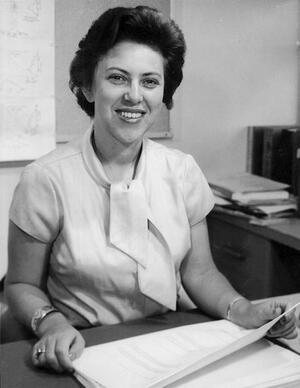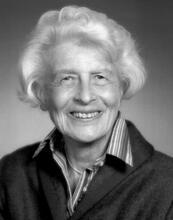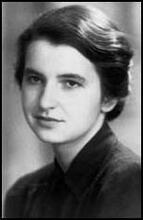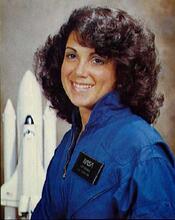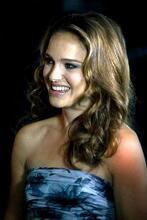Sulamith Goldhaber
Sulamith Löw Goldhaber’s pioneering work with particle accelerators put her at the forefront of a seismic shift in the research of particle physics. Her family immigrated from Vienna to Palestine, and Goldhaber later moved to the United States to complete her education and begin her career. Known as one of the best teams for studying nuclear emulsion technology, she and her husband made vital early discoveries about the interactions of K- mesons and protons. In the early 1960s, she switched from nuclear emulsions to the newly discovered bubble chambers and quickly became an expert in the field. Goldhaber was also the author of dozens of articles and traveled the world giving talks at scientific conferences.
Family and Education
Sulamith Löw was born in Vienna on November 4, 1923. Her parents, Abraham Löw (1884–1960) and Tova Reinisch (1891–1956) were both born in Galicia, which was then part of the Austro-Hungarian empire. They married in 1908. Her father was a businessman and her mother a homemaker. In 1910 her brother Samuel was born and in 1915 the family moved to Vienna where her sister Lola was born in 1917. The home environment was Orthodox and Zionist.
In 1938 the family emigrated to Palestine, settling in Tel Aviv, where Sulamith completed her high school education. In 1940 she continued her education at the Hebrew University in Jerusalem, where she met her future husband, Gerson Goldhaber. Gerson and Sulamith both received their master’s degrees in 1947, the year they were married. They then went to the United States where they earned their doctorates at the University of Wisconsin.
Career
From 1951 to 1953 Gerson had a junior faculty appointment at Columbia, working with the cyclotron, and Sula was a research associate in radiochemistry. Radiochemistry was an “intermediate state” that permitted her to learn and apply the techniques of nuclear physics and thereby make the otherwise “forbidden transition” from her original field of physical chemistry to high energy physics.
By the time Gerson went to Berkeley as an assistant professor in 1953, he and Sula had become one of the most competent American teams in the art and science of nuclear emulsion technology. They worked long hours together, setting up developing facilities for their emulsions and training a team of scanners and measurers. They had their eyes firmly on the Bevatron, which was about to become the world’s most powerful accelerator. From its earliest operating days, one or both of them seemed always to be waiting in a corner of the control room, in the hope that the busy crew would grant them a quick exposure of some kind. Because of their perseverance, they were rewarded with some of the earliest and most interesting observations of the interactions of negative K mesons with protons.
Goldhaber gave a memorable introductory talk on heavy mesons and hyperons at the 1956 Rochester Conference; much of what she reported was her own work. More than any other event in the history of the Rochester Conferences, her talk marked the turning point in the study of strange particles. Before then, cosmic ray physicists had reported almost all the experimental data; from then on, the field belonged almost exclusively to accelerator users.
Goldhaber’s bibliography shows many important papers among the 25 publications that resulted from her concentrated attack on Bevatron problems using the nuclear emulsion techniques. For example, she and Gerson were the first to observe the mass splitting of the charged Sigma hyperons. Sula also worked with most of the Berkeley exponents of the nuclear emulsion technique, observing the first nuclear interactions of the newly discovered antiprotons.
In the early 1960s, it became apparent that Sula Goldhaber should switch her attention from nuclear emulsions to bubble chambers. So, she and Gerson teamed with George Trilling in the formation of what is frequently called the Goldhaber-Trilling Group. After a transition period in which she published simultaneously on nuclear events in emulsion, propane, and hydrogen, she concentrated her scientific attention on liquid hydrogen bubble chambers for the rest of her life.
Goldhaber attacked the problems of hydrogen bubble chamber physics with the enthusiasm and vigor that had characterized all her earlier work. She was soon an acknowledged expert in the field, as her list of invited papers amply demonstrates. She was in great demand as a speaker at international conferences; she always had important things to say, and she expressed herself beautifully. She and her associates were long the world’s experts on the interactions of K + mesons with nucleons, and she played important roles in the discoveries of several “resonant states,” most notably the A mesons. She and Gerson first measured the spin of the K* meson; they are credited with the first study of the simultaneous production of pairs of resonant states, and they devised the “triangle diagram” to aid in such studies.
In the fall of 1965, Sula and Gerson started around the world on a sabbatical tour, visiting high energy physics laboratories, attending conferences, and giving lectures. After attending a conference at Oxford, the couple traveled to Ankara, where Goldhaber spent a month preparing the series of lectures she was to give in their next stop, Madras.
Death and Legacy
But in Madras, Goldhaber was suddenly stricken with a brain hemorrhage. Exploratory surgery revealed a brain tumor, and she died without recovering consciousness. To her countless friends all over the world, it was an unbelievable shock. It did not seem possible that someone who personified so much that was youthful and vivacious could suddenly be removed from their midst.
Sula had a fierce loyalty to all the things she loved, and they were many: her family, her religion, her two adopted countries, her science, her laboratory, and her friends. She managed concurrently to be several quite different and effective persons: a distinguished scientist, a remarkable homemaker and hostess, and a devoted wife and mother. She was missed for her important contributions to the many fields in which she labored, but most of all she was missed for the personal warmth she always radiated.
In 1965 the School of Physics and Astronomy at Tel Aviv University inaugurated an annual Sulamith Goldhaber Memorial Lecture; among the distinguished lecturers were three Nobel Laureates.: Professors Murray Gell-Mann, Steven Weinberg, and Carlo Rubbia.
Sulamith was survived by her brother Samuel, a heart physician in Tel Aviv, her sister Lola Capel in New York, her husband Gerson in Berkeley, California, and her only son Nathaniel, who was born in 1948.
Selected Works
“Mean Lifetime of Positive K Mesons,” Phys. Rev. 99: 1617 (1955), with E.L. Iloff, W.W. Chupp, G. Goldhaber, J.E. Lannuttii, A. Pevsner, and D. Ritson.
“The Lifetime of the tau-Meson,” Nuovo Cimento (Series 10) 2: 344 (1955), with W. Alvarez.
“K-meson Mass from a K-hydrogen Scattering Event,” Phys. Rev. 99: 1042 (1955), with W.W. Chupp, G. Goldhaber, W.R. Johnson, and J.E. Lannutti.
“Example of anti-proton nucleon annihilation” Phys. Rev. 102,921 (1956), with O. Chamberlain et al.
“Properties of Negative K-mesons,” Nuovo Cimento 8: 899 (1958), with F.H. Webb, E.L. Iloff, F.H. Featherston, W.W. Chupp, and G. Goldhaber.
“Pion-Pion Correlations in Antiproton Annihilation Events,” Phys. Rev. Lett. 3: 181 (1959), with G. Goldhaber, W.B. Fowler, T. Hoang, T.E. Kalogeropoulos, and W.M. Powell.
“Pi-pi correlations in p p-bar annihilation,” Phys. Rev.120,300, (1960) with G. Goldhaber, W.Lee and A.Pais.(known as the GGLP effect)
“On the Spin of the K* Resonance,” Phys. Rev. Lett. 9: 330 (1962), with W. Chinowsky, G. Goldhaber, W. Lee, and T.O’Halloran.
Copyright © University of California, Berkeley

